MONSTER OF THE WEEK!
Cool! MONSTERS!
This section is dedicated to the unique, odd, interesting, and just plain unusual monsters that can be found in the Chronicles of Ember. Each Sunday, a new creature will be added to the list to provide an in-depth view of the creature in question!
10/1/23
Mummy
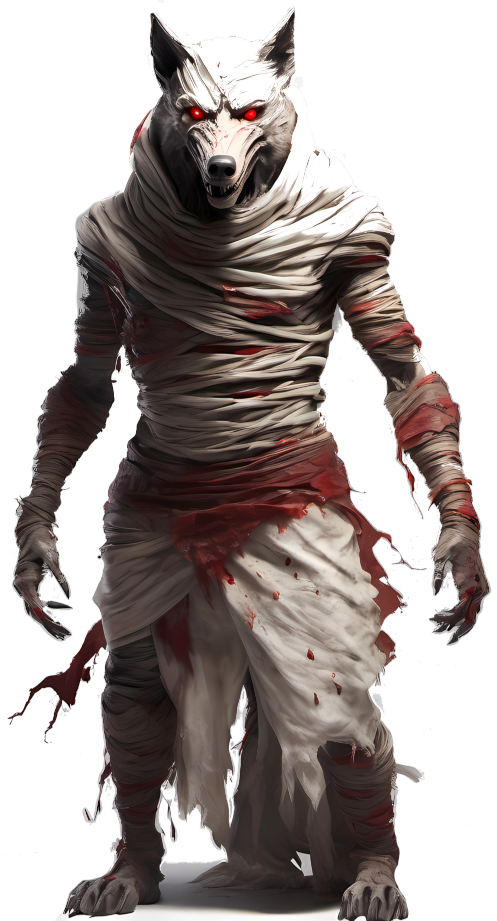
The Mummy is a macabre and ancient figure, shrouded in tattered bandages and preserved through dark embalming rites. Its withered body radiates an aura of death and decay. The Mummy is a vessel of curses and malevolent magic, often set to guarding long forgotten tombs or cursed treasures. They are among the most powerful of undead creatures, bested only by Vampires and Liches in terms of raw power. Unsurprisingly, they can be turned as Mummies.
ECOLOGY:
Mummies are the result of dark rituals, binding malevolent spirits to preserved corpses. These cursed entities are often found guarding tombs, ancient relics, or cursed sites. Their chilling presence and connection to curses make them feared and reviled by those who encounter them. They are unnatural creatures, and have no place in the ecosystem.
COMBAT ADVICE:
Engaging a Mummy should be done with caution. Its rotting grasp can inflict both immediate damage and a long-term curse, while its ability to curse enemies can significantly hinder their effectiveness in combat. Players should aim to remove curses through magical means and be prepared to endure necrotic damage. While slow-moving and stiff, they pack a powerful punch.
SPECIAL ATTACKS
Rotting Grasp – A successful melee touch attack inflicts necrotic damage. The target must make a saving throw vs. Death Magic (PPDM) or be afflicted with Mummy Rot. This is a curse, not a disease, and spells such as Cure Disease have no effect upon it.
Mummy’s Curse – Once per encounter, the Mummy can target a creature within 30 feet and bestow a curse upon it. The curse’s effect varies and can be tailored to fit the mummy’s backstory or the campaign’s themes.
SPECIAL DEFENSES
Negative Plane Immunity – A mummy is immune to damage from Negative Energy sources.
Mundane Weapon Resistance – Mummies take only half damage from non-magical bludgeoning, piercing, and slashing weaponry. A +1 or better weapon is required to do full damage to these creatures.
9/24/23
Mushmouse
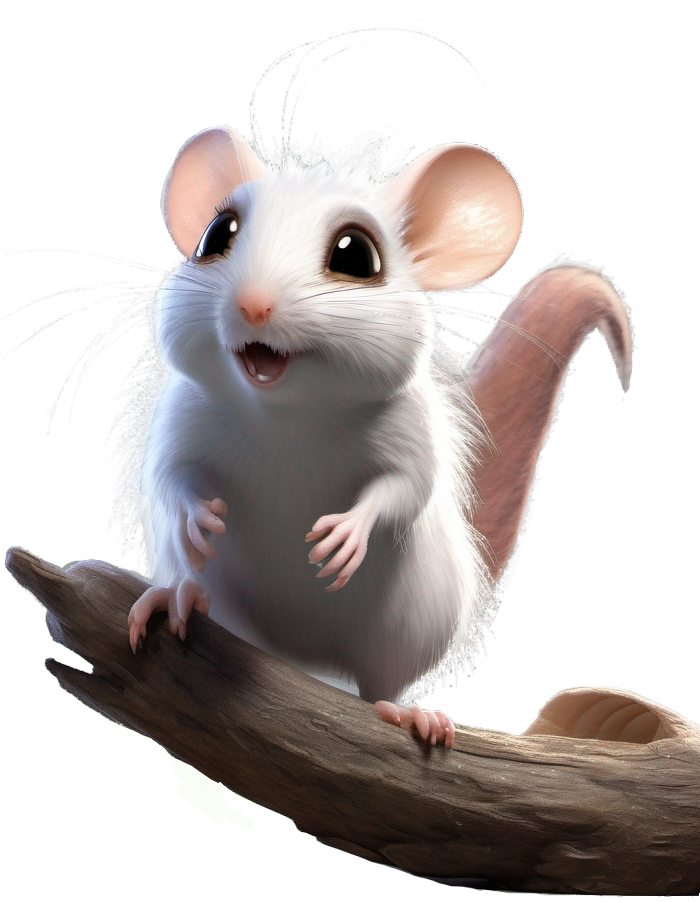
The Mushmouse is a small, largely defenseless creature with an endearing appearance which has become quite popular as a pet. With large eyes, oversized tail, and a perpetual derpy expression, the Mushmouse is like a ball of fluff brought to life. Its most distinguishing characteristic is its tendency to emit high-pitched squeals in response to any and all stimuli.
ECOLOGY:
Mushmice are beloved pets due to their cute appearance and quirky behavior. They are often found in homes and gardens, where they provide companionship and entertainment. Their tendency to squeal in response to stimuli can evoke both amusement and exasperation from their caretakers.
When encountered in the wild, they are most often found making their homes in richly forested regions with a preference for old-growth areas. They prefer to live among the fungi, taking shelter from the elements beneath the caps of larger mushrooms. As a quirk of their evolution, Mushmice are completely immune to the effects of mushroom and toadstool toxins, even the legendary Destroying Angel Amanita,
COMBAT ADVICE:
Combat involving Mushmice is highly unlikely, given their non-aggressive and diminutive nature. Players should exercise caution and restraint around these creatures, treating them with the care and tenderness befitting their status as pets.
9/17/23
The Noue
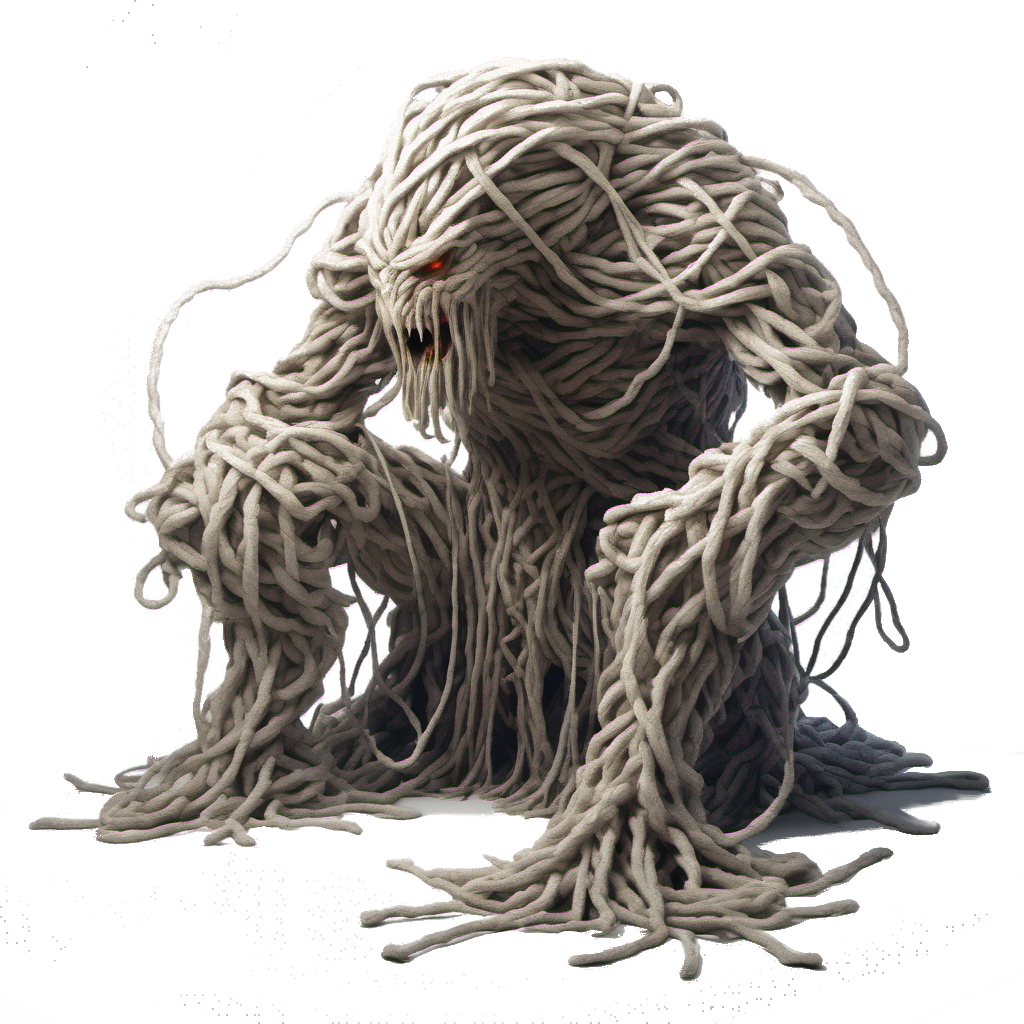
The Noue is a terrifying and unsettling creature, appearing as a twisted mass of living knots, composed of tightly intertwined ropes, vines, or sinew that constantly writhe and shift as if with a life of their own. The knots vary in size and tightness, creating a nightmarish patchwork of bulges, loops, and tangles. The creature lacks discernible limbs, instead using its shifting knots to move with an unnatural agility.
ECOLOGY:
The Noue’s origins remain shrouded in mystery, with several compelling theories attempting to explain their existence. Some speculate that Noues are Awakened creatures, their once mundane forms transformed into the enigmatic beings they are now. Others propose that they might be escaped denizens of a ruptured Dreamscape from the Deep Ethereal Plane, manifesting in the Prime Material Plane as a result. An intriguing conjecture suggests that Noues could be the constructs of ambitious Prime Material mages, their creations intended to serve as an innovative form of golem.
Life Cycle: Regardless of their origin, little is known about the Noue’s life cycle, and it is a subject that continues to elude thorough examination. Their methods of reproduction, if they indeed reproduce, remain elusive, making it challenging to ascertain the developmental stages or propagation of Noues.
Diet: The Noue does not require sustenance in the traditional sense, as its existence defies the laws of nature. Instead, it seems to feed off the fear and life force of its victims. It hunts with a predatory instinct, seeking to ensnare its prey within its knots and either immobilize them for its malevolent enjoyment or extract their life force through unknown means.
Activity Cycle: Noues predominantly display a nocturnal activity cycle, favoring the shroud of darkness for their pursuits. Daylight hours see them retreat to hidden refuges, reserving their hunting and movement for the cover of night.
Habitat and Behavior: Noues exhibit a distinct preference for concealed and overgrown habitats associated with darkness and decay, frequently inhabiting dense forests, marshlands, or intricate cave systems. They often find refuge amidst tangled underbrush, where their appearance blends seamlessly with the surroundings, making them difficult to detect until it is too late. These creatures possess an innate malevolence that drives them to seek out and ensnare living beings. They seem to revel in causing fear and suffering, using their entangling knots to tighten and constrict prey.
Hunting Strategies: Noues employ ambush tactics as their primary hunting strategy. Patiently concealed within their chosen habitats, they deploy their entangling knots to ensnare unsuspecting prey. Once a victim is caught, the Noue gradually tightens its living ropes, subduing and immobilizing its quarry before feeding upon it.
Interactions With Others: Noues typically lead solitary lives, avoiding interactions with both their own kind and other creatures. Encounters between Noues are infrequent and often result in territorial disputes. Such confrontations are characterized by intricate displays of living knots, with the defeated party typically retreating to seek an alternative territory. However, Noues have never been known to parley and seem either unaware or uninterested in attempting to communicate with members of other species. Sages conjecture that to a Noue, all is prey, and they seek only to seize, strangle, and kill those which gain their interest.
Role in the Ecosystem: A Noue is not a “natural” creature and does not appear to have evolved alongside the local ecosystem. It is an invasive species by any measure, and its presence only serves to disrupt any environment into which it is thrust. It has no known predators in the traditional sense. However, its bane seems to be the common rat, as a swarm of these creatures can serve to break down a Noue’s body through incessant gnawing in a long-running battle of attrition.
Cultural Significance: Noues have become the subjects of numerous myths and legends among cultures that share their habitats. Some depict them as malevolent forest spirits, while others see them as embodiments of the hidden dangers lurking within the wilderness. Certain cultures associate Noues with symbols of mystery and the unseen.
The Noue’s origins continue to be a subject of intrigue and speculation, with various theories attempting to shed light on their existence. While their true nature remains elusive, their ecological role and cultural significance persist as fascinating subjects of study and interpretation.
COMBAT ADVICE:
Engaging with a Noue requires both physical strength to withstand its Constricting Knots and mental resilience to resist its Entangling Presence. Players should focus on breaking free from restraints and avoiding prolonged eye contact with the creature to avoid its fear-inducing abilities.
9/10/23
ARCTIC SMILODON
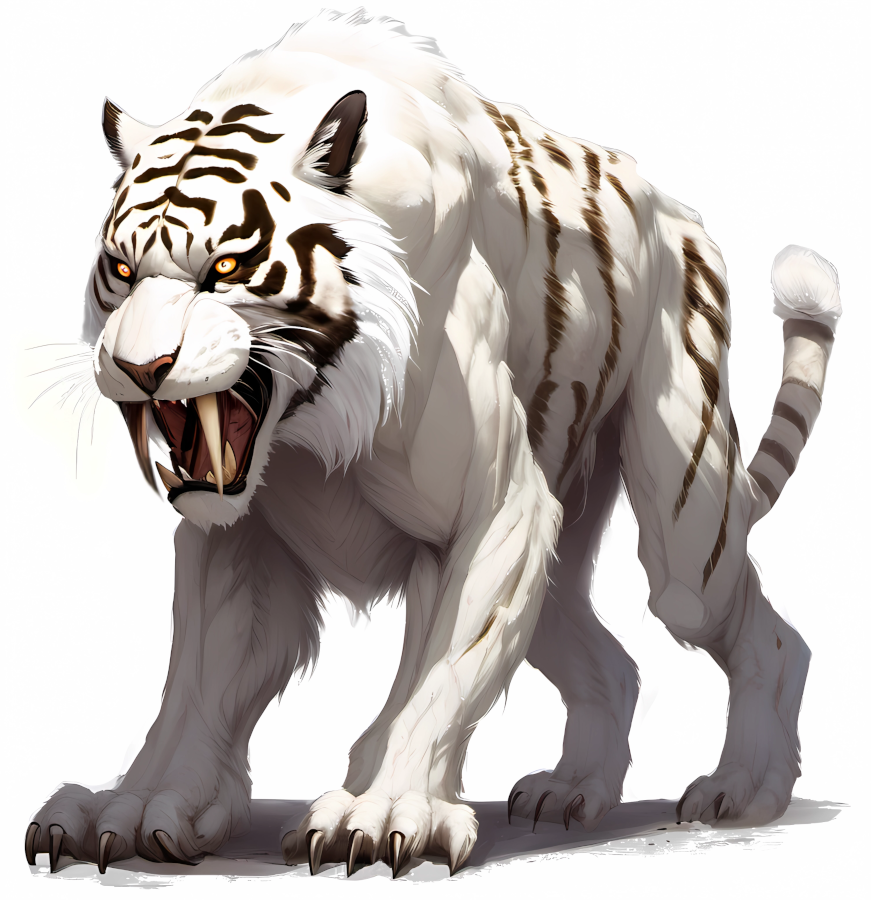
The Smilodon is a fearsome arctic predator, resembling a massive saber-toothed tiger adapted to the harsh and icy wilderness. With its muscular build and thick fur, it stands at nearly 4 feet tall and measures over 7 feet in length, making it an imposing sight. The most distinctive feature of the Smilodon is its long, razor-sharp canines, extending up to 11 inches in length. These formidable teeth allow it to deliver deadly bites to its prey.
ECOLOGY:
Life Cycle: The Arctic Smilodon has evolved to thrive amidst the snow-covered landscapes and icy tundras. Smilodons are solitary by nature, with the exception of breeding season when they seek out potential mates. Their life cycle consists of distinct phases, including birth, adolescence, adulthood, and eventually, old age. They typically live 10-15 years in the wild before becoming prey themselves. In captivity they can live for as long as 22 years.
Diet: As carnivores, Smilodons are top predators in their frigid habitat. Their diet primarily consists of large herbivorous mammals adapted to the cold, such as tundra lords and muskoxen. The Smilodon’s impressive size and strength enable it to take down these formidable prey. Their hunting techniques are calculated and strategic, often involving coordinated attacks on larger targets. While other carnivores may safely consume the remains of Smilodons, omnivores often find their meat unpalatable, described as bitter, overly gamey, and even potentially toxic.
Activity Cycle: Smilodons are well-adapted to the frigid arctic environment and tend to be more active during the colder months when their prey is also on the move. They are known for their endurance and ability to traverse snow-covered landscapes efficiently. During the warmer months, when resources are more abundant, they may become less active, conserving energy for the challenging winter ahead. Habitat and Behavior: The Smilodon’s habitat encompasses the vast, snow-covered expanses of the arctic region. Their dense fur, layer of blubber, and cold-resistant adaptations enable them to endure extreme cold. These solitary predators are highly territorial and fiercely defend their hunting grounds from other predators, ensuring a consistent supply of prey. Smilodons are known for their stealth and patience when stalking potential victims.
Hunting Strategies: Smilodons employ a variety of hunting strategies, including ambushes, coordinated attacks on larger prey, and stalking techniques. They rely on their powerful physique and sharp teeth to bring down their quarry. These predators are known for their calculated and efficient hunting methods, ensuring a successful kill even in the harsh arctic environment.
Interactions With Others: Smilodons are primarily solitary creatures, and their interactions with others of their kind are limited to the mating season. During this time, they seek out potential mates, and disputes among males may arise. Otherwise, they are highly territorial and tend to avoid encounters with other predators in their habitat.
Role in the Ecosystem: As top predators in the arctic ecosystem, Smilodons play a critical role in regulating the population of herbivorous mammals. By controlling the numbers of species like tundra lords and muskoxen, they help maintain the balance of the ecosystem and prevent overgrazing of vegetation. Smilodons are essential to the health and diversity of their habitat.
Cultural Significance: Smilodons hold a significant place in the cultures and mythologies of indigenous arctic peoples. They are often regarded as symbols of strength, resilience, and adaptability to harsh environments. In some cultures, Smilodons are revered as powerful totem animals or spirits that embody the spirit of the arctic wilderness. Their presence in stories, art, and rituals reflects their cultural significance and deep connection to the natural world.
COMBAT ADVICE:
When facing a formidable predator like the Smilodon, adventurers must approach the encounter with caution and strategic thinking. Here are some combat advice and tips for dealing with the arctic saber-toothed tiger:
First, an Arctic Smilodon would much rather attack soft targets such as mounts and draft animals that don’t fight back quite as hard. They prefer to lunge for the neck in such cases, allowing their canines to pierce the throat from the side and simply rip it out with a twist of their necks, scoring an instant kill before running away from any angry adventurers. Guard your beasts of burden well.
Avoid their bite at all costs. The Smilodon is a close-range attacker with powerful jaws. Spells or abilities that can slow down or immobilize the Smilodon temporarily can give your party more time to deal damage or regroup. Use crowd control tactics strategically. Web spells and other means to keep their mouths closed are excellent ways to open combat.
Stay back if you can. Melee combatants should exercise caution when engaging it directly. Ranged attackers should maintain a safe distance, taking advantage of their ranged weapons or spells to chip away at its health from afar.
Smilodons are both tenacious and skilled at ambushing their prey, doing so every chance they get. Be attentive to signs of its presence, such as tracks or disturbances in the snow. Use Observation checks (if you have the skill), to detect the creature before it can initiate a surprise attack.
Coordination is crucial when facing such a deadly predator. Be prepared for a prolonged battle and ration your resources accordingly. Conserve spells and abilities for critical moments in the fight. Work as a team to distract and flank the Smilodon, preventing it from focusing its attacks on a single target. Smilodons are fierce and relentless in their pursuit. Ensure that weaker or more vulnerable party members are protected from direct attacks. Position tanks or defensive characters between the Smilodon and those who can’t withstand its powerful bites. Try to draw it away from its lair or separate it from its potential allies. Distracting or isolating the creature can give your party a significant advantage in combat.
As an arctic creature, the Smilodon is vulnerable to fire and resistant to cold-based attacks. Exploit this weakness by using fire-based spells or weapons to maximize damage.
If the encounter becomes too dangerous, consider a tactical retreat to regroup and plan a more strategic approach. Smilodons are not reckless, and they may disengage if the battle turns against them.
The Smilodon is exceptionally well-adapted to the freezing temperatures of its arctic habitat. It has a natural resistance to cold-based attacks and environmental effects. Cold spells or abilities that might freeze or slow down other creatures have a diminished effect on the Smilodon.
Smilodons are incredibly agile predators. They have a heightened sense of danger and can instinctively evade attacks with exceptional speed and grace. The Smilodon gains advantage on Dexterity saving throws to avoid area-effect spells or traps.
The Smilodon’s white fur provides excellent camouflage in snowy environments, making it challenging for adversaries to spot it until it strikes. It has advantage on Dexterity (Stealth) checks when hiding in snowy terrain.
The Smilodon’s large paws and claws are well-suited for moving on icy terrain and snow-covered surfaces. It has advantage on climbing checks while navigating icy cliffs or slippery landscapes.
9/03/23
THE TARRASQUE
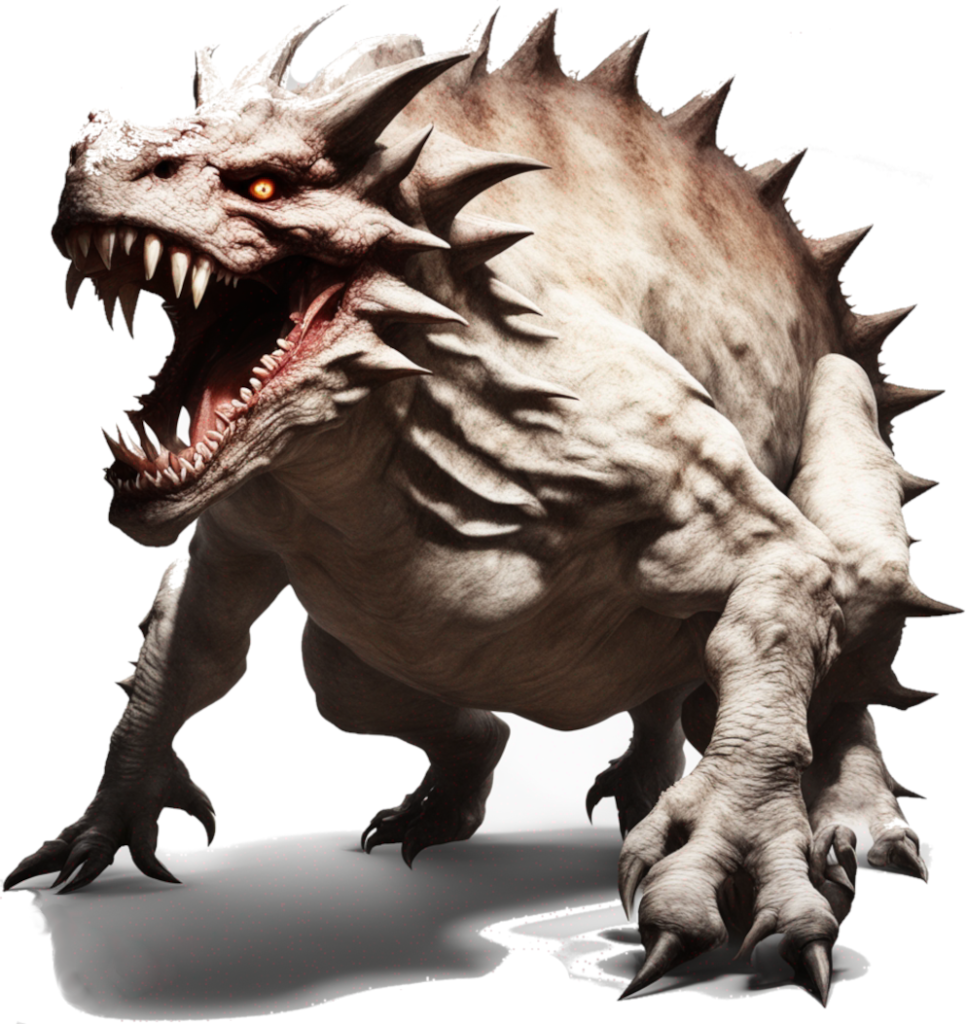
DESCRIPTION:
The Tarrasque stands as a legendary monstrosity of colossal proportions, striking fear into all who encounter it. It boasts a length of 250 feet and a staggering weight of 175,000 pounds. Its appearance melds reptilian and insectoid traits, with an armored carapace adorned by jagged spikes and bony protrusions that accentuate its raw, destructive might. Rows of razor-sharp teeth fill its gaping maw, capable of rending foes apart. Though its movement may seem lumbering, the Tarrasque’s sheer speed when charging into battle shakes the earth with every massive step.
ECOLOGY:
Life Cycle: The Tarrasque’s life cycle is one of relentless power. It emerges as a force of chaos and destruction, growing in strength as it consumes and rampages. Its lifespan spans untold years, marked by its insatiable appetite and inexorable growth. The Tarrasque’s existence is a perpetual cycle of carnage and regeneration, ensuring its dominance as an apex predator.
Diet: The Tarrasque’s diet is voracious and indiscriminate. It devours everything in its path, from creatures to plant life and structures. Its appetite fuels its regenerative capabilities, allowing it to mend wounds and regrow damaged portions of its body through the consumption of living matter.
Activity Cycle: The Tarrasque’s activity knows no bounds. It is a creature of ceaseless motion, moving from one area to another in a relentless search for sustenance. Whether by day or by night, its colossal presence looms over the landscape, leaving devastation in its wake.
Habitat and Behavior: The Tarrasque’s habitat is ever-changing, as it traverses various terrains in its unending quest for food. It is a solitary creature, showing no inclination towards forming social bonds. Its behavior is driven by its insatiable hunger and the primal urge to consume, laying waste to ecosystems and civilizations alike.
Hunting Strategies: The Tarrasque is an apex predator, its size and strength allowing it to overwhelm prey with sheer force. It employs brute force and ferocity, using its massive jaws and claws to tear through anything in its path. Its very presence instills terror in creatures, often causing them to flee in the face of its destruction.
Interactions With Others: The Tarrasque’s interactions with other creatures are minimal, as it is a solitary hunter that leaves little room for negotiation or cooperation. Its path of devastation leaves survivors to tell tales of its destructive nature and the need for preparedness against its onslaught.
Role in the Ecosystem: The Tarrasque’s role is that of an uncontrollable force of nature. It disrupts ecosystems, reshapes landscapes, and leaves a trail of destruction in its wake. Its presence challenges the balance of nature, pushing other creatures to adapt to its sporadic and cataclysmic appearances.
Cultural Significance: Legends and tales of the Tarrasque are cautionary tales, warning of the consequences of unchecked power and insatiable greed. Its name evokes dread and serves as a reminder of the fragile harmony between civilizations and the untamed wilderness.
COMBAT ADVICE:
Facing the Tarrasque demands a well-coordinated strategy and unyielding bravery. A direct confrontation proves perilous due to its colossal size and regenerative abilities. Exploit its slower movement and attack patterns using hit-and-run tactics. Employ ranged weapons and potent arcane spells of 8th level or higher to erode its health gradually. Divine spells will not work. Prioritize disrupting its regeneration with spells or abilities that target healing effects. Make sure you keep an escape plan handy, because this fight will go badly.
Understand, first and foremost, that if this creature can be killed, no one has ever done it. Even reducing it to 0 hit points does not stop its regeneration – it will get back up, and it will be very angry about this.
SPECIAL DEFENSES:
Regeneration: At the onset of its turn, the Tarrasque restores a significant amount of hit points, rendering it challenging to weaken through standard attacks.
Immunity to Spells: All spells of 7th level or lower (both arcane and divine) hold no sway over the Tarrasque, rendering many magical effects ineffective against it.
8/27/23
FIRE GIANT
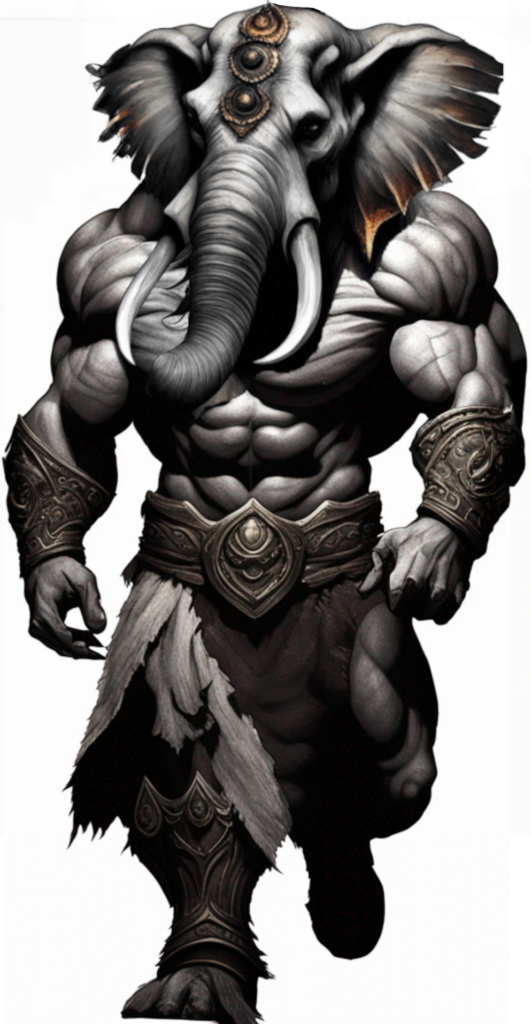
The Fire Giant, a towering and powerful creature of ancient legend, is said to have once roamed the volatile landscapes near volcanoes, harnessing the inferno’s might to fuel their fiery prowess. Standing at an imposing height, these giants possess a unique and awe-inspiring appearance. Their colossal bodies are reminiscent of the sturdy frame of an elephant, with a thick, muscular build and a fierce, determined countenance. Their skin is ashen and hardened, adorned with rugged patterns and scars earned from the harsh environment they call home. Atop their necks, they bear the head of an elephant, complete with sharp tusks and blazing eyes that mirror the intensity of the molten lava flows that surround them.
ECOLOGY:
Though the existence of Fire Giants has become the stuff of myth and tales, these creatures were once believed to have inhabited the very edges of fiery calderas and seething volcanic landscapes. Revered by some and feared by others, these giants are thought to have harnessed the power of the blazing elements, commanding flames with an affinity that defied the mortal realm. Their society, if it ever existed, might have been a complex and disciplined hierarchy, with a reverence for the destructive beauty of their fiery domain.
COMBAT ADVICE:
Should a Fire Giant truly exist, it is imperative to approach any encounter with both caution and preparation. While their mastery over fire grants them an unmatched advantage, exploiting their vulnerability to cold spells can be a key strategy in weakening their formidable defenses. Engaging from a distance and utilizing ranged attacks could help mitigate the risks posed by their fiery nature. Additionally, coordinating attacks and using terrain to one’s advantage can prove essential, as the sheer power and resilience of these giants could easily overpower an uncoordinated assault.
SPECIAL DEFENSES:
The Fire Giants’ inherent immunity to fire is their most renowned and fearsome attribute. However, this very affinity also leaves them uniquely susceptible to the biting chill of cold magic. Spells of frost and cold can sear their fiery essence, dealing twice the normal damage. This peculiar vulnerability serves as both their bane and a potential source of hope for those who dare to challenge these mythical beings.
8/20/23
THE HUSK
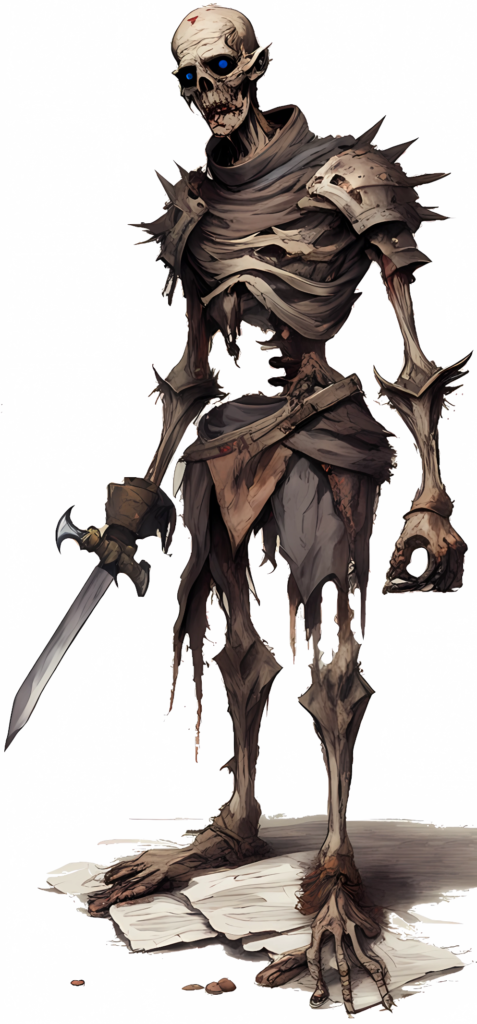
Husks are eerie undead creatures that resemble mummies, often mistaken for zombies at a glance. These desiccated figures stand at a height of 5 to 6 feet, with shrunken and mummified bodies covered in tattered and rotting bandages. Despite their emaciated appearance, Husks exhibit a graceful and purposeful movement, defying their zombie-like reputation. Their eyes, though clouded and hollow, contain a dim, pearlescent glow, exuding an unsettling sense of awareness and malevolence.
ECOLOGY:
Husks are created through necromantic means, either by powerful necromancers to serve as guardians or by the presence of Draugs, ancient undead entities. They retain much of their former skills and abilities, making them formidable opponents. Their origins are shrouded in mystery, and while they do not shamble like mindless undead, they are often bound to specific locations, such as tombs. Husks possess an uncanny understanding of spoken language, although reports of them verbally communicating are scarce.
COMBAT ADVICE:
When confronting Husks in combat, adventurers should be cautious of their tactical prowess and silent coordination with one another. These creatures work together to outmaneuver their opponents, often relying on their enhanced intelligence and retained skills. Be prepared for surprises, as Husks can invoke words of power against their enemies, causing various detrimental effects. Engaging Husks as a group requires a strategic approach and coordination among the party members.
SPECIAL ATTACKS:
Words of Power – Husks have a 25% chance to invoke words of power against their enemies. This ability allows them to cause damage, inflict blindness, induce madness, inspire fear, or trigger traps. The specific effect is determined by the nature of the encounter and the narrative context.
SPECIAL DEFENSES:
Undead Traits – Husks possess traits typical of undead creatures, including immunity to poison, sleep, paralysis, and disease. They do not require air, food, drink, or sleep.
Resilient Mind – Due to their mummy-like nature, Husks have advantage on saving throws against spells and effects that would charm, dominate, or manipulate their minds.
8/13/23
THE DRACOLICH
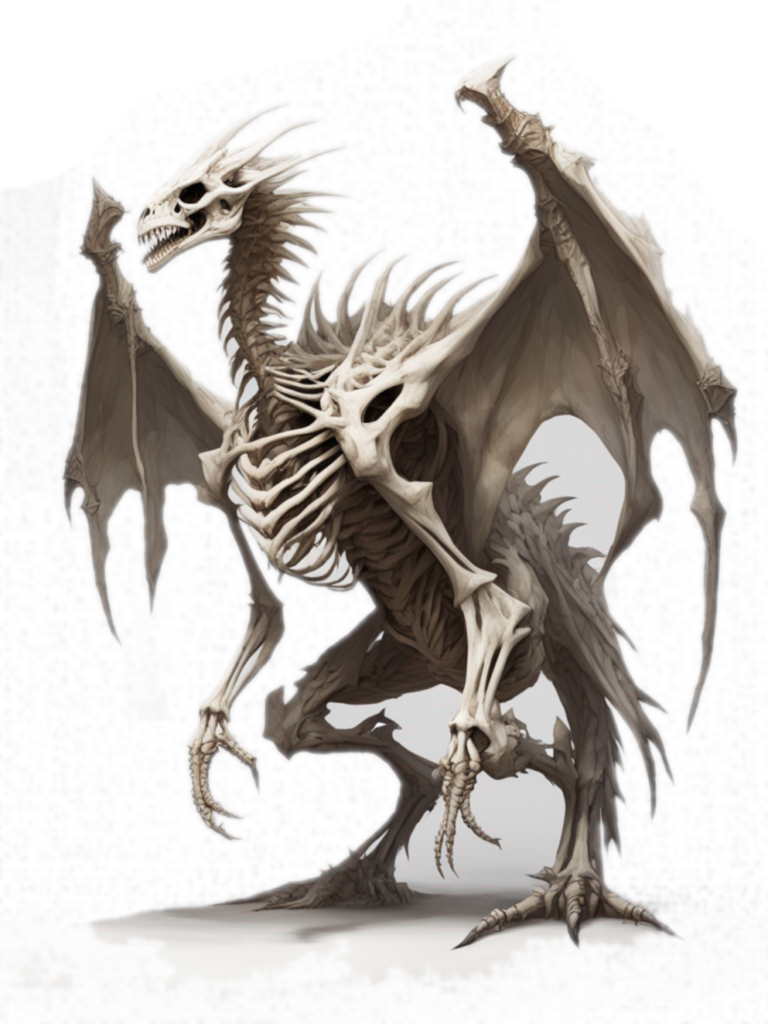
A Dracolich is a terrifying and unholy fusion of a dragon’s majestic form and the malevolent power of undeath. This nightmarish creature is the result of a dragon’s corpse being raised from the grave through dark necromantic rituals, transforming it into a fearsome and relentless undead abomination. Its skeletal frame retains the imposing size and shape of its living counterpart, its bones eternally preserved and adorned with tattered remnants of scales and decaying flesh.
The Dracolich’s eye sockets emit an eerie, unholy light, casting a haunting glow that pierces through the darkness. Its bony wings, tattered and skeletal, remain a haunting reminder of the creature’s once-majestic flight. Claws as sharp as razors and a jagged-toothed maw evoke a sense of dread in those who behold its visage. The very air around a Dracolich is laden with an aura of death and decay, chilling the hearts of even the bravest adventurers.
Bound by dark magic and necrotic energy, a Dracolich possesses an aura of malevolence that exudes an overwhelming sense of doom. It is a creature driven by malevolent intelligence and sinister purpose, no longer burdened by the noble traits that once defined its living counterpart. Instead, the Dracolich is driven by a thirst for power, dominance, and the eternal pursuit of dark knowledge.
The sight of a Dracolich descending from the sky or emerging from the shadows is enough to strike fear into the hearts of even the most stalwart heroes. Its skeletal form and unholy presence serve as a grim testament to the perversion of life and the depths to which necromantic magic can corrupt the once-majestic essence of a dragon.
ECOLOGY:
The creation of a Dracolich is a sinister and forbidden ritual that binds the essence of a deceased dragon to the realm of undeath. Necromancers, dark cults, or malevolent sorcerers often seek to attain this dark power, driven by a desire to wield the immense strength and magical abilities of a dragon for their own nefarious purposes.
To create a Dracolich, the body of a deceased dragon must be prepared through meticulous and gruesome rituals. The dragon’s remains are carefully preserved, often through the use of dark magic and alchemical substances that slow decay. Necromantic spells are then cast, infusing the skeletal frame with the malevolent energy of the undead. The result is a horrifying fusion of draconic power and necrotic corruption.
Once brought back to undeath, a Dracolich’s existence is sustained by the same necrotic forces that brought it to life. It is free from many of the physical limitations of its living form, making it an even more formidable and dangerous adversary. Dracoliches are often drawn to sites of great magical power or ancient knowledge, seeking to expand their necromantic abilities and increase their dominion over both the living and the dead.
These abominable creatures are driven by a relentless thirst for power and an insatiable hunger for the souls of the living. They may amass followers and cults who revere them as dark overlords, spreading fear and corruption in their wake. Dracoliches are often found in remote, desolate areas, hidden away from the prying eyes of those who would seek to destroy them.
The creation and existence of a Dracolich are considered abominations by most societies, and the destruction of such a creature is often seen as a heroic and righteous endeavor. However, facing a Dracolich in battle is no small feat, as its unholy powers and mastery over death make it a formidable and nightmarish opponent.
Dracoliches are quite rare. On Ember, there have been known to be two, and both are now confirmed to be destroyed. However, the knowledge to make them is out there, and that means more cannot be far behind.
When confronting a Dracolich in combat, one must approach the encounter with strategic precision. The undead nature of these skeletal dragons demands careful consideration. Foremost, anticipate the necrotic magic they wield, and take precautions against such dark energy. Equipping the party with magical weapons capable of piercing their defenses is crucial. Spells or abilities that harness positive energy can also be a potent asset, disrupting their undead essence.
Engaging a Dracolich requires mobility and evasion. Its relentless assault mandates tactics that promote movement and dispersion, preventing the creature from targeting multiple allies simultaneously. Utilizing invisibility, teleportation, or misty step can effectively evade its attacks. Furthermore, divine spells imbued with positive energy can deliver substantial harm to these creatures. Bringing light-based magic can exploit their vulnerability to positive forces.
Strategically dismantle a Dracolich’s power by disrupting its phylactery. Investigate its lair for hidden phylacteries, aiming to weaken or eliminate the creature’s source of undeath. Engaging with area-of-effect spells to control the battlefield and counter its undead minions is recommended. Lastly, consider the environment as an ally, using hazardous terrain to weaken the Dracolich’s abilities. A united and coordinated approach, drawing upon the unique strengths of each party member, is essential to triumph over this formidable foe.
Above all else, expect to see magic you’ve never even heard about before when engaging these creatures.
SPECIAL DEFENSES:
The Dracolich possesses an array of formidable special defenses that set it apart as a nightmarish adversary. Its skeletal constitution renders it immune to effects that target the mind or rely on sensory perceptions, such as charm, fear, or illusions. These undead dragons are insusceptible to poisons, diseases, and other maladies that would afflict living creatures. Additionally, the Dracolich’s lack of vital organs grants it immunity to critical hits, ensuring that traditional methods of exploiting weaknesses are largely futile.
Drawing upon the necrotic essence that sustains it, the Dracolich displays a natural resistance to magical effects. Spells or abilities that rely on elemental damage are only half effective against it, as it is capable of dampening and partially negating such energies. Moreover, its unholy nature confers 50% resistance to damage from divine spells or holy magic that would otherwise be its bane.
The Dracolich’s mastery over death magic further manifests in its ability to shrug off the debilitating effects of death and decay. It is immune to effects that would cause it to age or wither, preserving its undead form indefinitely. This defiance of the natural order grants it exceptional resilience against spells or abilities that manipulate time or life force.
8/06/23
THE ICE MEPHIT
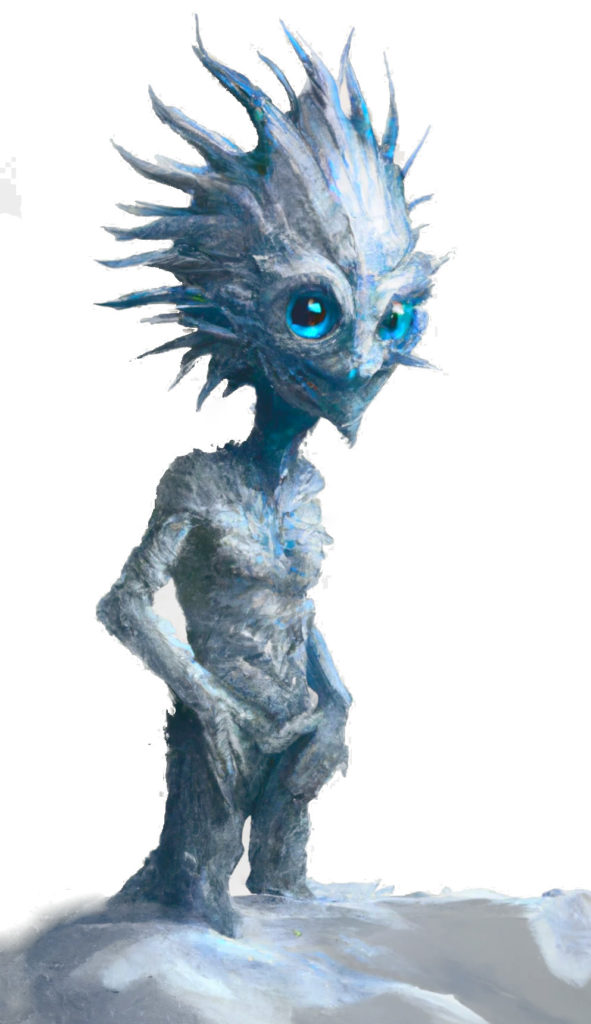
The Ice Mephit is a small, impish creature, measuring about 2 feet in length. Its body is composed of shimmering ice crystals, giving it a translucent and glacial appearance. Icy-blue veins course through its form, glowing softly with an inner chill. It has sharp, icicle-like claws and a waif-like figure allowing it to easily blend into wintry landscapes. The creature’s large, expressive eyes shine like sapphires, revealing a mix of mischief and intelligence. They are known for their ability to manipulate and summon snow and ice at will. They speak only a gibbering dialect common to the Paraelemental plane of Ice. Among the weakest of all elemental-kin, ice mephits do not seem to understand or care that their pranks can cause a good deal of harm to those native to the Prime Material plane, and apparently they find doing so quite amusing.
ECOLOGY:
The Ice Mephit resides in frozen and snow-covered regions, such as arctic tundras, icy caverns, or frosty mountaintops. It is most active during the coldest months and thrives in places where the temperature drops significantly. The creature’s breath and touch are attuned to its icy environment, enabling it to manipulate ice and create frigid auras. The Ice Mephit plays a vital role in its habitat, breaking down ice formations to allow sunlight to penetrate, aiding in plant growth, and carving out ice caves that serve as shelter for other creatures during harsh winters. It is not native to Ember, but originates on the Paraelemental plane of Ice.
COMBAT ADVICE:
When facing a Ice Mephit in combat, adventurers should be wary of its ice-based abilities. The icy mist from its breath can chill and slow down opponents, while its frost touch can cause cold damage. It often uses hit-and-run tactics, taking advantage of its flying ability to dart in and out of combat. To counter its glacial aura, adventurers should bring warm clothing or magical protections. Ranged attacks are effective, as they can keep the creature at a distance and avoid its freezing touch. Fire-based spells and weapons are particularly useful, as they can weaken the Ice Mephit’s icy defenses and deal significant damage.
SPECIAL DEFENSES:
The Ice Mephit’s icy nature grants it some unique defenses. It is immune to cold damage, and its icy form makes it resistant to slashing and piercing attacks. Should it be threatened, it can merge with the surrounding snow and ice, rendering it immune to direct damage while in this form. However, it also cannot do anything else while merged, save fleeing its attacker. The glacial aura it emits can create patches of difficult terrain, hampering movement for those caught in its proximity. The creature’s agility and small size make it challenging to hit in combat. It can also temporarily freeze water sources, transforming them into icy hazards, and can extinguish flames with its glacial aura.
7/30/23
THE BLOODFLY
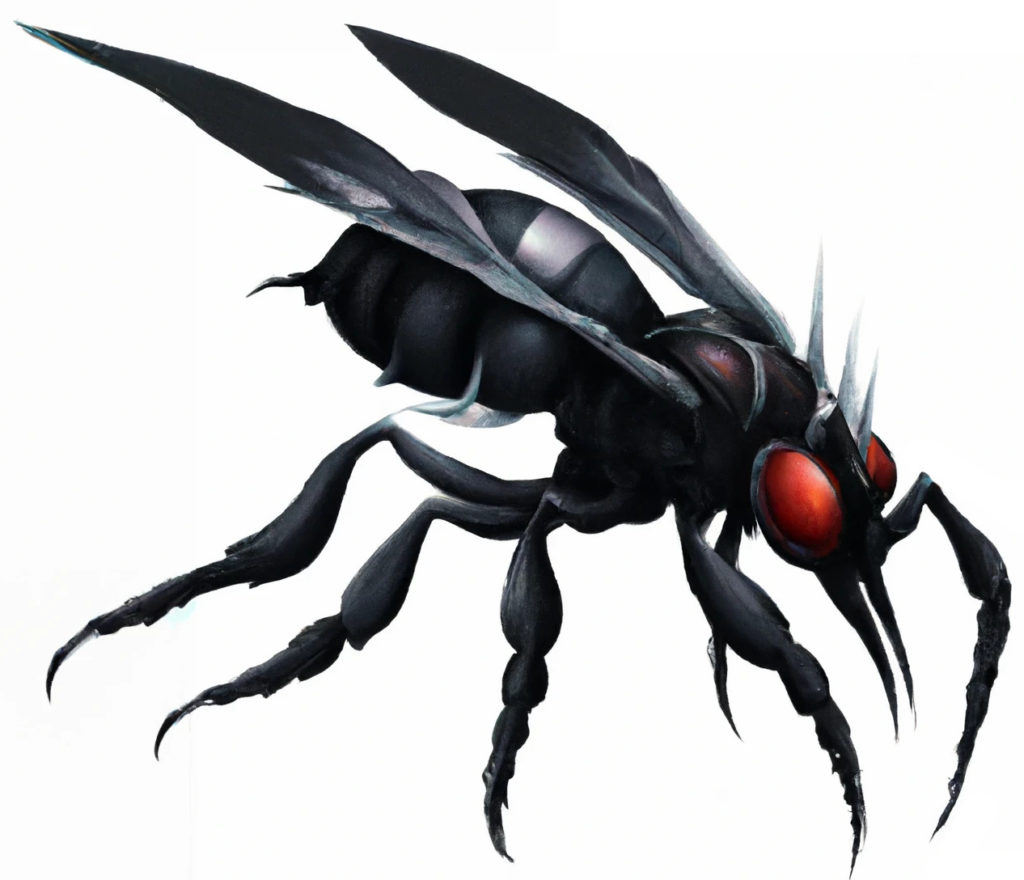
DESCRIPTION:
The bloodfly is a large insect, about the size of a man’s thumb, resembling an oversized horsefly. Its entire body is covered in a hard black carapace, giving it natural armor and protection against physical attacks. The most striking feature is its vivid red eyes that seem to glow with an otherworldly intensity. Bloodflies emit a deep, ominous buzzing noise while in flight, and a swarm of these creatures creates a terrifying cacophony. Their putrid odor surrounds them, blending with the stench of decay in their natural habitats. Possessing eight arachnid-like legs and a pair of functional, wasp-like wings, they exhibit extraordinary agility and aerial maneuvers.
ECOLOGY:
Bloodflies are carnivorous insects that prefer to feed on the putrid flesh and bodily fluids of the dead, making them integral to the decomposition process in their ecosystem. They also carry numerous diseases associated with decay, making them dangerous vectors for spreading illnesses like gangrene, blood poisoning, and necrosis. Bloodflies are known to swarm around sources of heat and blood, detecting potential prey from a distance. They lay eggs in or near carrion, and their offspring, known as clotworms, continue the feeding process before metamorphosing into adult bloodflies. The nocturnal creatures are most active during the night or in dark environments, relying on their keen sense of smell and collective behavior to stay one step ahead of potential threats.
Moreover, when lighting upon living mammalian beings such as cattle or humanoids, the bloodfly lays eggs directly on the skin of the victim. The heat of the skin causes the eggs to immediately hatch into microscopic clotworm maggots, which seek out pores in the skin and burrow inside to gestate. A large pustule is formed, and within a week the growing clotworm maggot causes the tissues inside to necrose, which it consumes. After ten days, the pustule ruptures, freeing the newly formed bloodfly to seek out prey and continue the cycle. As a result, they are reviled by all sapient races. Not surprisingly, the Bloodfly is sacred to Duruk and his church.
A clotworm infestation can be fatal if not treated, as each pustule is rarely a single event. Fortunately a “Cure Disease” spell can clear the infestation at any time before the pustule ruptures.
COMBAT ADVICE:
Combat against bloodflies requires careful strategy and preparation. Area-of-effect spells like “Burning Hands,” “Thunderwave,” or “Cone of Cold” can disperse or damage swarms. Precise ranged attacks, such as those from archers or crossbow users, can target individual bloodflies. Fire-based attacks are particularly effective due to their attraction to heat. Melee fighters must employ swift and precise swatting movements to strike them down. Area denial spells like “Wall of Fire” or “Vermin Ward” can obstruct their flight path. Using protective gear and repellents can guard against disease transmission. Diversion and distraction tactics can lure bloodflies into traps or confined spaces, making them vulnerable.
Getting indoors is always your best bet. But even then, those bloodflies which invariably will make it inside with you are legendary for their ability to avoid being hit. The slightest puff of air puts them to flight. Spells have been devised (see above) to specifically take care of these creatures. However, if you have no other option, a large sheet or blanket can be thrown to capture them and pin them to the floor where they can be summarily squashed flat.
SPECIAL DEFENSES:
The bloodfly’s hard carapace provides natural armor, making them less susceptible to physical attacks. Their evasive flight maneuvers and swift aerial movements make them difficult to hit. Bloodflies’ swarm behavior allows them to quickly regroup and reform, avoiding concentrated damage. They emit a putrid odor, camouflaging themselves within the scent of decay. Bloodflies react aggressively to threats, becoming more frenzied and focused on attacking. They can disperse and relocate quickly, using mobility and speed to their advantage. Their nocturnal adaptation grants them enhanced vision in low-light conditions. Swarm sensory perception acts as an early warning system, alerting the collective entity to potential danger.
7/23/23
THE ORC
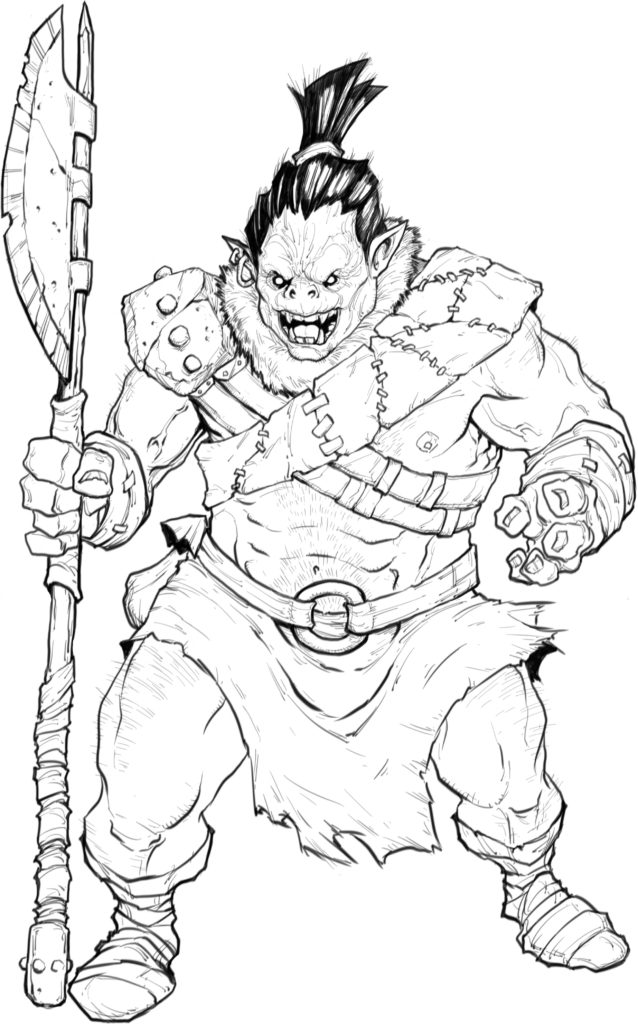
Orcs resemble large, heavily muscled humans with dark gray skin, red eyes, heavy brow ridges, and sloping foreheads. The nose of an orc is almost non-existent and instead resembles a snout. Orcs typically stand 6’6″ in height and weigh 300 pounds. Hair color varies from dark brown to blue-black. Their jaws are wide-set, and their mouths sport enlarged canines which jut from the lip. Preferring to live in blasted and hard-bitten rocky terrain, orcs feel much about a virgin forest as a human does about a black, fetid swamp. Orcs typically speak their own guttural tongue known as Thuluuk and/or a few other languages such as Common and a horribly broken Futharken.
ECOLOGY:
These creatures are warm-blooded with an incredibly dense hide. They are capable of enduring the most extreme weather conditions with very little in the way of protection from the elements. However, they do recognize the utility of footwear and loin coverings. They are also known to keep pets, after a fashion, and commonly raise Warg for companions and beasts of war. While omnivorous, orcs can survive and even thrive on a carnivorous diet. They reach adulthood at age 17, and their maximum lifespan is estimated to be about 80 years, although most die much younger than this due to their warmongering lifestyle and general violent society. To an orc, there is no greater honor than dying in battle, except perhaps the rape and pillage of ones enemies. Battle and bloodsport drive the orc mind to ecstasy, and they are easily drunk with the taste of blood and combat. With the onset of puberty, orcs of both sexes gain the power to enter a state of rage. While enraged, an orc feels no pain, and is enraptured by violence and carnage. They can willingly enter this state in 10 tics, and the rage persists until all foes are defeated or the orc is dead. It is said that the scent of blood or the sounds of battle can drive an orc into this state against his will. Typical Orc society is barely above the stone age, with clothing and gear being made with hide and sinew. Most tribes know the secret of working with iron (although steel eludes them). They recognize the superiority of steel, and will confiscate it for their own use whenever they can as spoils of war. Their equipment is often crude and heavy, but it will stand up to punishment – at least for a while.
COMBAT ADVICE:
Orcs are natural fighters, and take delight in destruction and killing. When in combat, orcs can enter a berserk blood-frenzy, which enhances these destructive and murderous tendencies. Orcs do not take prisoners unless commanded to do so by those powerful enough to dominate them. Conversely, orcs in the blood-frenzy never surrender, fighting to the death. Woe be to the man who attempts to corner an orc!
SPECIAL DEFENSES:
Orcs are famously resistant to cold, and are considered to have a damage reduction of 3 from exposure or magical attacks which are cold-based. When enraged, they are immune to all mind-affecting spells and effects including ESP, charm person, and even the mental intrusions of Alvani. Those Alvani who have tried to breach the mind of an orc in such a state describe the experience as being caught in a violent, blood-red storm.
7/16/23
DRAUG
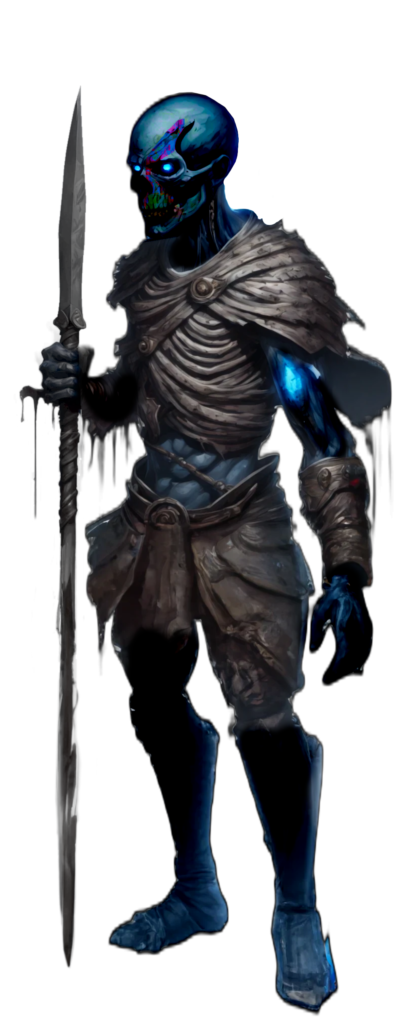
Draug are the specially embalmed bodies of wealthy persons which have been desiccated and had their flesh reconstituted with pitch. This embalming technique is harsh on a corpse, and little of the candidate’s physical appearance survives the process. The flesh of draug is generally a gloss black, shriveled tight, and hard as wood to the touch. The hair of the scalp, when present, is matted with pitch and slicked back. The lips often will have peeled back into a sardonic grin to reveal bright white teeth, while disturbingly sunken eyes sport pinpoints of pearlescent blue light. The faces of draug are gaunt, and their bodies are both muscular and skeletal. They are almost always made from human bodies, although in theory any corpse should suffice.
Draug are said to be easily mistaken for zombies in the poor light of their barrow, but are much more nimble.
ECOLOGY:
These undead humanoids are found only in the Grand Dutchy. Resembling black fleshed, gaunt humans, these living dead are the mortal remains of strong-willed persons who have undergone funerary rites unique to the far north. They can be created intentionally to serve as guardians, although most come into being on their own.
Rather than allowing the bodies to lie in state on a funerary slab or interring the remains in a grave, the important dead of the Grand Dutchy first undergo a lengthy preservation process. The body is first packed with salts for a month to desiccate the remains and prevent decay. This has the effect of giving the entire body a shriveled and sunken appearance. Once the corpse has been cured in this manner, it is immersed in a bath of thin pitch for another ten days. During this time, the dry flesh absorbs the pitch and seals the body against all intrusion by insects and scavengers. Upon completion of this process, the body is sealed in a funerary barrow. Commonly this type of burial is accompanied by the material wealth of the deceased. As the process is expensive, only the most wealthy and powerful can afford the process.
COMBAT ADVICE:
Draug are capable of understanding any languages they knew in life, although they rarely speak. More often than not they attack ferociously, seeking to drive intruders from their tomb. Their claws are sharp enough to rend leather. Draug still possess all the skills they did in life, and will use their treasure to best effect against intruders.
If you face a draug, lure it from its barrow if you can – they are nigh invulnerable while within their tomb. As a result of their embalming process, they are also quite susceptible to fire. However the best advice for dealing with one of these creatures is to drop whatever you stole from their barrow and run.
SPECIAL DEFENSES:
It is said they are immune to being turned or commanded by high level priests while within their barrow, and cannot be coerced into leaving it by any means, save retrieving loot taken by grave robbers, and only enchanted weapons have any hope of doing damage to their bodies. They are also incredibly strong, and their touch can freeze flesh.
7/9/23
Ebonhorn
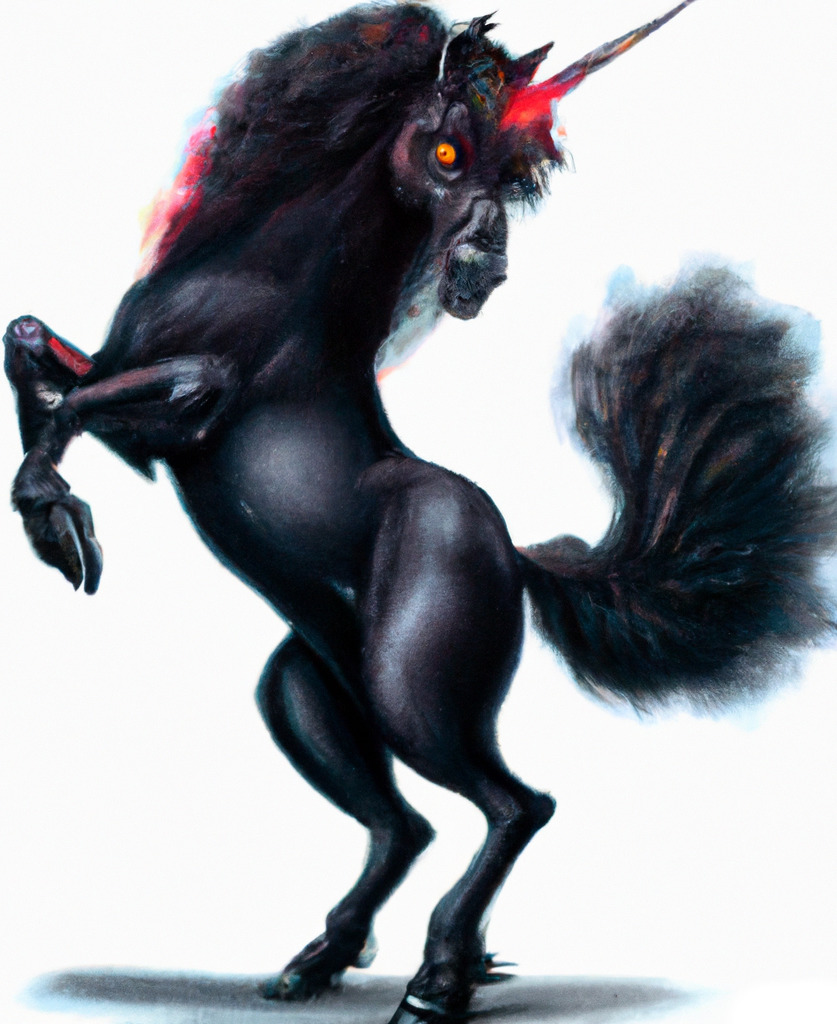
DESCRIPTION:
Ebonhorns resemble sickly looking horses, with a black coat, mane, hooves, and tail, eyes which may be red to yellow, and a scintillating red and black glowing horn growing from their foreheads. They are considered harbingers of doom. Found in fel places, they are highly intelligent, and can teleport between shadows at will.
ECOLOGY:
Native to the Demiplane of Shadow, the Ebonhorn is a malevolent and elusive creature, a sinister manifestation of darkness and power. Some have suggested that Ebonhorns are related to Nightmares, but sages agree that the similarity largely ends at their coloration and temperament, and are no more closely related to one another than they are a common draft horse.
As its name suggests, its coat is as black as the deepest night, absorbing light and radiating an eerie darkness that seems to swallow the very essence of its surroundings. Its presence is foreboding, as if it heralds the arrival of impending doom. Some describe the mere act of simply viewing an Ebonhorn to be physically painful.
The Ebonhorn stands at around 16 hands tall (roughly 65 inches), and resembles a traditional unicorn in its general morphology, yet every aspect of its appearance exudes a malevolent energy. Its eyes, usually a vibrant shade of crimson or piercing yellow, glimmer with an unsettling gleam, reflecting an inner wickedness. A long, twisted black horn emerges from its forehead, curving and spiraling into a dangerous point, serving as both a symbol of its power and a deadly weapon.
Rather than exuding a positive aura like unicorns, the Ebonhorn is surrounded by an aura of darkness, shrouding its very being in a miasma of shadow. This aura amplifies its sinister nature, infusing its surroundings with an oppressive sense of unease. The aura exerts a sphere of baneful influence to a range of 25 feet, and those within this aura suffer disadvantage to all die rolls. As the Ebonhorn moves, its hoofbeats echo with an otherworldly resonance, striking fear into the hearts of those unfortunate enough to hear it.
Legends speak of the Ebonhorn as a creature with an insatiable hunger for chaos and suffering. It is said to thrive on negativity, drawing strength from the darkest emotions and feeding off the fear and despair it incites. With a malicious intelligence, it is known to haunt desolate and cursed lands, preying on lost souls and ensnaring them within its wicked influence.
The Ebonhorn’s dark and twisted powers make it capable of casting malefic spells and weaving curses upon its victims. Its magic is fueled by the corrupted energies that flow through its ebony form, allowing it to manipulate shadows, conjure dark illusions, and unleash devastating attacks upon those foolish enough to oppose it.
7/2/23
THE ASH ZOMBIE
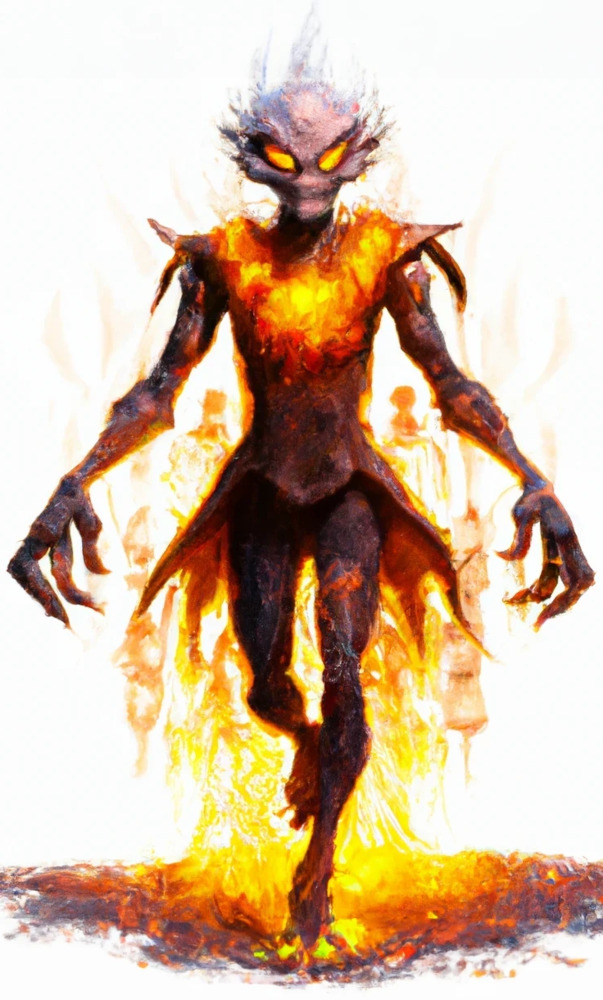
Most frequently found in volcanic regions, the Ash Zombie is a haunting manifestation of the undead, forged from the charred remains of individuals who have met their demise in a devastating inferno. These wretched creatures are cursed to roam the earth, trapped between life and death, their existence forever linked to the relentless and destructive power of fire.
Ash zombies bear the unmistakable scars of their fiery demise. Their bodies are covered in layers of ash, resembling burnt and crumbling flesh. The remnants of their clothing are tattered and singed, barely clinging to their skeletal frames. The eerie glow of smoldering embers lingers within their hollow eye sockets, casting an ominous light that betrays their lifeless state.
These undead monstrosities are driven by an insatiable hunger for warmth and life energy, their connection to fire compelling them to seek out sources of heat and vitality. They are drawn to flames, be it flickering candles, roaring bonfires, or the fiery life force that animates the living. This insidious attraction allows them to track their prey with unerring accuracy, relentlessly pursuing any semblance of life that crosses their path.
Despite their shambling appearance, ash zombies possess a twisted strength that defies their decaying forms. Their charred limbs, now skeletal and brittle, are still capable of delivering bone-crushing blows to their unfortunate victims. Their touch is searing, capable of scorching the flesh and leaving behind painful, smoldering wounds.
One of the most chilling aspects of the ash zombie is its ability to manipulate fire. With a mere gesture, these undead beings can summon and control flames, creating a menacing aura of burning heat around them. They can conjure fiery projectiles, hurling them at foes with deadly accuracy, or engulf their surroundings in an inferno, reducing everything in their path to ash and cinders.
To confront an ash zombie is to face the relentless fury of the flames themselves, as their burning touch and pyromantic abilities make them formidable adversaries. Only the most courageous and skilled individuals dare to challenge these creatures, armed with fire-resistant gear, potent magical wards, and a resolve unyielding in the face of such an unholy abomination.
The sight of an ash zombie is a chilling reminder of the destructive force fire wields and the horrifying consequences it can unleash upon the living. These undead husks serve as harbingers of the destructive power that resides within the elemental force, forever bound to the flames that brought about their twisted existence.
6/25/23
THE ALVESCHI
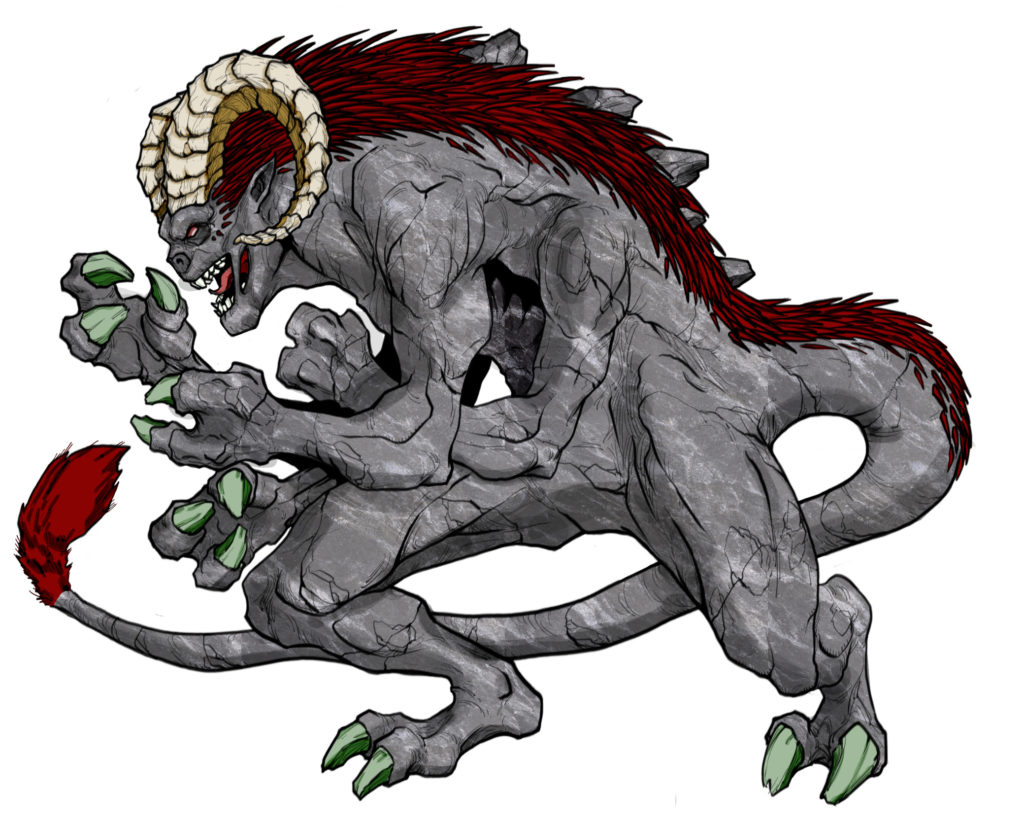
Primal Trolls (known as “Alveschi” in the ancient tongue of the Elves) are horrid, feral beasts with large, powerfully built trunks, freakishly corded necks, and enormous jaws containing a double row of razor-sharp teeth. Typically they weigh around 1,200 pounds. Their fingers and thumbs are without nails, but instead end in a wicked enamel claw which replaces the final joint. Alveschi have deep black eyes that are wide spaced in their ape-like faces, and they have a tendency to drool. The most alien feature of these creatures is that they possess six limbs upon an elongated humanoid trunk. Their plated bodies can be any combination of gray and tan in color with the texture of stone. They are most often razorbacked. The tails of Primal Trolls are long, horned, and scaly, ending in a tuft of hair much like that of a lion. They often possess magnificent racks of recurved antlers, resembling those of rams.
Primal Trolls are incredibly aggressive and fierce hunters who will often launch themselves haphazardly at their quarry, however they have been occasionally known to lay an ambush against superior numbers. Their six limbs grant magnificent climbing and mountaineering abilities, and thus allow them to scamper up and over sheer cliff faces should the need arise. However it is more likely they will do so with the intent of launching themselves upon prey from above. Their natural ability to blend in with rocky terrain only makes things worse. These creatures regenerate damage at an astonishing rate, and only fire or acid can prevent them from doing so. Avoid these creatures at all costs. If you must fight them, brandish fire and pray to your gods for aid.
6/18/23
THE ICE DRAKE
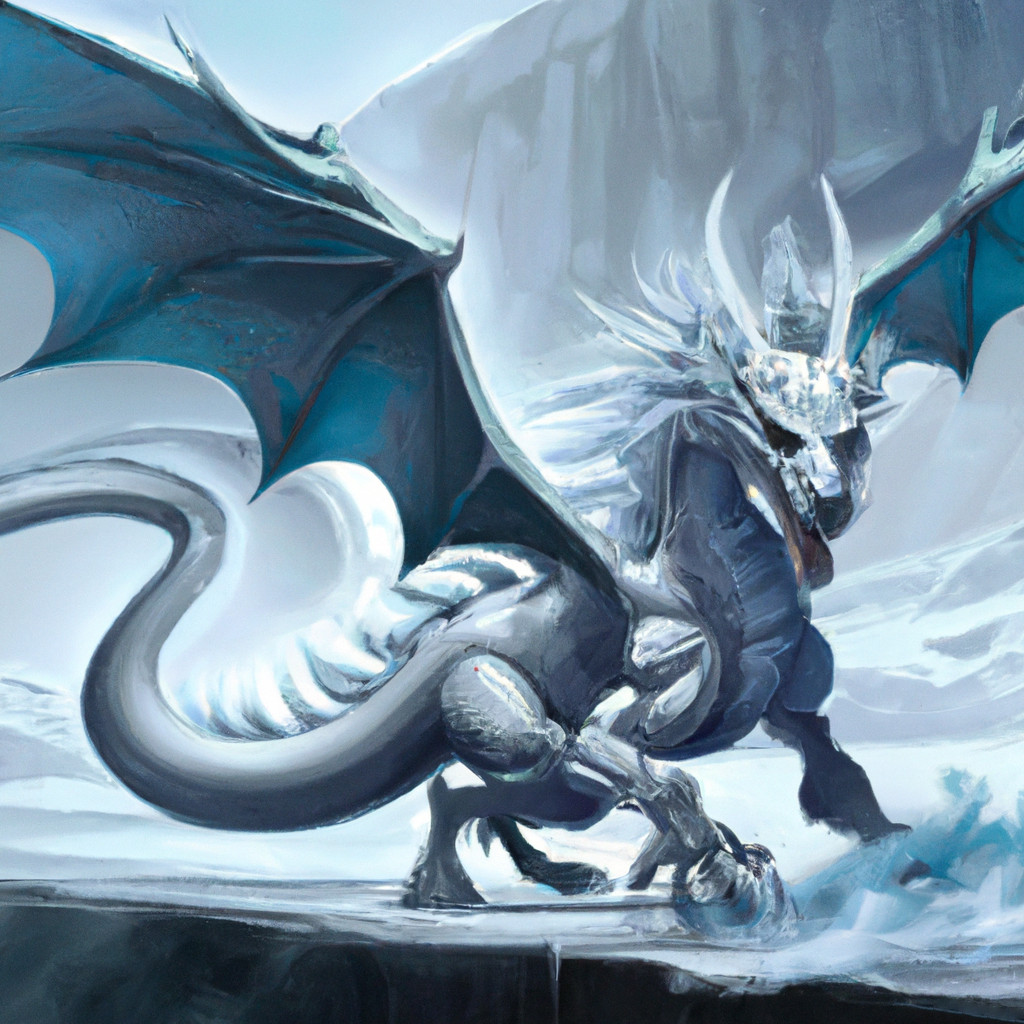
These reptilian creatures are frequently mistaken on first sight for young white dragons. However they are neither as powerful nor intelligent. They respond to any stimulus with a blast of frost breath. This small creature is around 4 feet long and a little over 2 feet in height, and possesses the proportions of a miniature white dragon, but its hide is thinner and more translucent. They are completely immune to cold damage, and their blood is reported to freeze upon contact with air. Sages say it is this property which powers an Ice Drake’s breath weapon, which it may use up to five times daily. Silith nobles have been known to keep them as pets and watchdogs. White dragons consider them vermin. Their blood is valuable as a spell component for ice-based casting.
